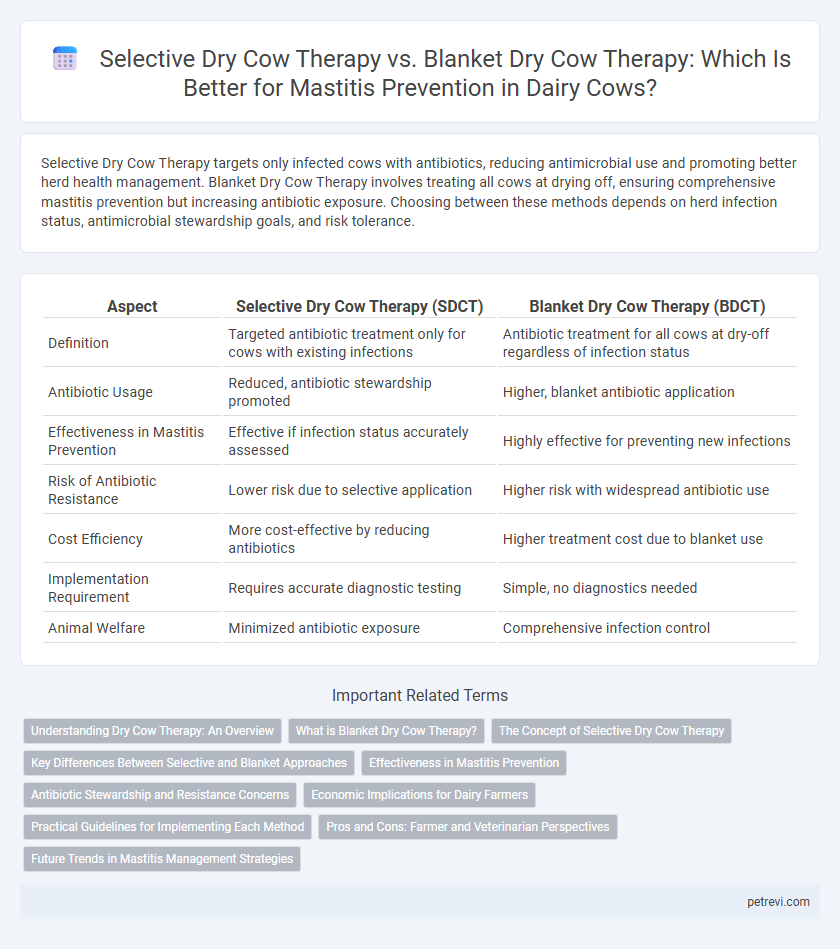Selective Dry Cow Therapy targets only infected cows with antibiotics, reducing antimicrobial use and promoting better herd health management. Blanket Dry Cow Therapy involves treating all cows at drying off, ensuring comprehensive mastitis prevention but increasing antibiotic exposure. Choosing between these methods depends on herd infection status, antimicrobial stewardship goals, and risk tolerance.
Table of Comparison
| Aspect | Selective Dry Cow Therapy (SDCT) | Blanket Dry Cow Therapy (BDCT) |
|---|---|---|
| Definition | Targeted antibiotic treatment only for cows with existing infections | Antibiotic treatment for all cows at dry-off regardless of infection status |
| Antibiotic Usage | Reduced, antibiotic stewardship promoted | Higher, blanket antibiotic application |
| Effectiveness in Mastitis Prevention | Effective if infection status accurately assessed | Highly effective for preventing new infections |
| Risk of Antibiotic Resistance | Lower risk due to selective application | Higher risk with widespread antibiotic use |
| Cost Efficiency | More cost-effective by reducing antibiotics | Higher treatment cost due to blanket use |
| Implementation Requirement | Requires accurate diagnostic testing | Simple, no diagnostics needed |
| Animal Welfare | Minimized antibiotic exposure | Comprehensive infection control |
Understanding Dry Cow Therapy: An Overview
Selective Dry Cow Therapy targets only infected cows or quarters by using antibiotics during the dry period, minimizing antibiotic use and reducing resistance risk. Blanket Dry Cow Therapy, involving the treatment of all cows at drying off, ensures broad prevention of mastitis but may contribute to antibiotic overuse. Understanding these approaches is crucial for effective mastitis control and dairy herd health management.
What is Blanket Dry Cow Therapy?
Blanket Dry Cow Therapy involves administering antibiotics to all cows at drying off, regardless of infection status, to prevent mastitis during the dry period. This approach aims to eliminate existing infections and protect udders from new bacterial invasion by treating every quarter uniformly. While effective in reducing clinical mastitis incidence, Blanket Dry Cow Therapy raises concerns about antibiotic overuse and resistance development.
The Concept of Selective Dry Cow Therapy
Selective Dry Cow Therapy (SDCT) targets only infected cows with antibiotic treatment at dry-off, reducing overall antibiotic use while effectively preventing mastitis. This approach relies on accurate cow-level diagnosis, including somatic cell count and milk culture testing, to identify infections and promote prudent antimicrobial stewardship. Compared to Blanket Dry Cow Therapy, SDCT supports cow health by minimizing antibiotic resistance risk and maintaining udder immunity in uninfected cows.
Key Differences Between Selective and Blanket Approaches
Selective Dry Cow Therapy targets only infected or high-risk cows, reducing antibiotic use and lowering antimicrobial resistance. Blanket Dry Cow Therapy treats all cows at drying off, ensuring comprehensive mastitis prevention but increasing antibiotic exposure. The selective approach emphasizes diagnostic testing and tailored treatment, while the blanket method prioritizes broad-spectrum coverage without individual assessment.
Effectiveness in Mastitis Prevention
Selective Dry Cow Therapy (SDCT) targets only cows or quarters with existing intramammary infections, reducing antibiotic use while maintaining mastitis prevention effectiveness. Blanket Dry Cow Therapy (BDCT) treats all cows uniformly at drying-off, offering a broad-spectrum approach but contributing to increased antibiotic resistance. Studies indicate SDCT achieves comparable mastitis prevention rates to BDCT when robust diagnostic tools guide therapy selection.
Antibiotic Stewardship and Resistance Concerns
Selective Dry Cow Therapy (SDCT) targets only cows or quarters with identified intramammary infections, reducing unnecessary antibiotic use compared to Blanket Dry Cow Therapy (BDCT), where all cows receive antibiotics regardless of infection status. SDCT supports antibiotic stewardship by minimizing antibiotic exposure, thereby decreasing the risk of antimicrobial resistance development in mastitis pathogens. Implementing SDCT aligns with sustainable dairy farming practices, promoting cow health while addressing public health concerns associated with antibiotic resistance.
Economic Implications for Dairy Farmers
Selective Dry Cow Therapy (SDCT) reduces antibiotic usage by treating only infected cows, leading to significant cost savings on medication compared to Blanket Dry Cow Therapy (BDCT), which treats all cows regardless of infection status. Studies indicate SDCT can lower overall treatment expenses by up to 30% while maintaining similar mastitis prevention effectiveness, enhancing herd health management efficiency. Economic benefits of SDCT include reduced antibiotic resistance risks and compliance with regulatory restrictions, supporting sustainable dairy farming profitability.
Practical Guidelines for Implementing Each Method
Selective Dry Cow Therapy targets infected cows by administering antibiotics only to those with a history or presence of mastitis, reducing antimicrobial use and resistance risk. Blanket Dry Cow Therapy involves treating all cows at drying-off, ensuring comprehensive mastitis prevention but increasing antibiotic exposure. Practical implementation requires accurate udder health assessment, culture-based diagnostics for selective therapy, and strict hygiene protocols during treatment to maximize efficacy and minimize infection risks.
Pros and Cons: Farmer and Veterinarian Perspectives
Selective Dry Cow Therapy targets infected quarters, reducing antibiotic use and the risk of antimicrobial resistance, which appeals to veterinarians promoting sustainable practices. Farmers benefit from cost savings and improved milk quality but may face challenges in accurately identifying infected cows and the risk of under-treating potential infections. Blanket Dry Cow Therapy ensures comprehensive infection control, simplifying management, yet it increases antibiotic exposure and raises concerns over drug residues and resistance from both veterinary and agricultural viewpoints.
Future Trends in Mastitis Management Strategies
Selective Dry Cow Therapy (SDCT) is increasingly favored over Blanket Dry Cow Therapy (BDCT) due to its targeted antibiotic use, which reduces antimicrobial resistance and supports sustainable dairy farming. Advances in diagnostic technologies, including on-farm somatic cell count testing and pathogen-specific molecular assays, enable more precise treatment decisions that enhance mastitis control. Future trends in mastitis management emphasize precision medicine, integration of automated monitoring systems, and genetic selection for mastitis-resistant cow breeds to optimize udder health and productivity.
Selective Dry Cow Therapy vs Blanket Dry Cow Therapy for Cow Mastitis Prevention Infographic

 petrevi.com
petrevi.com